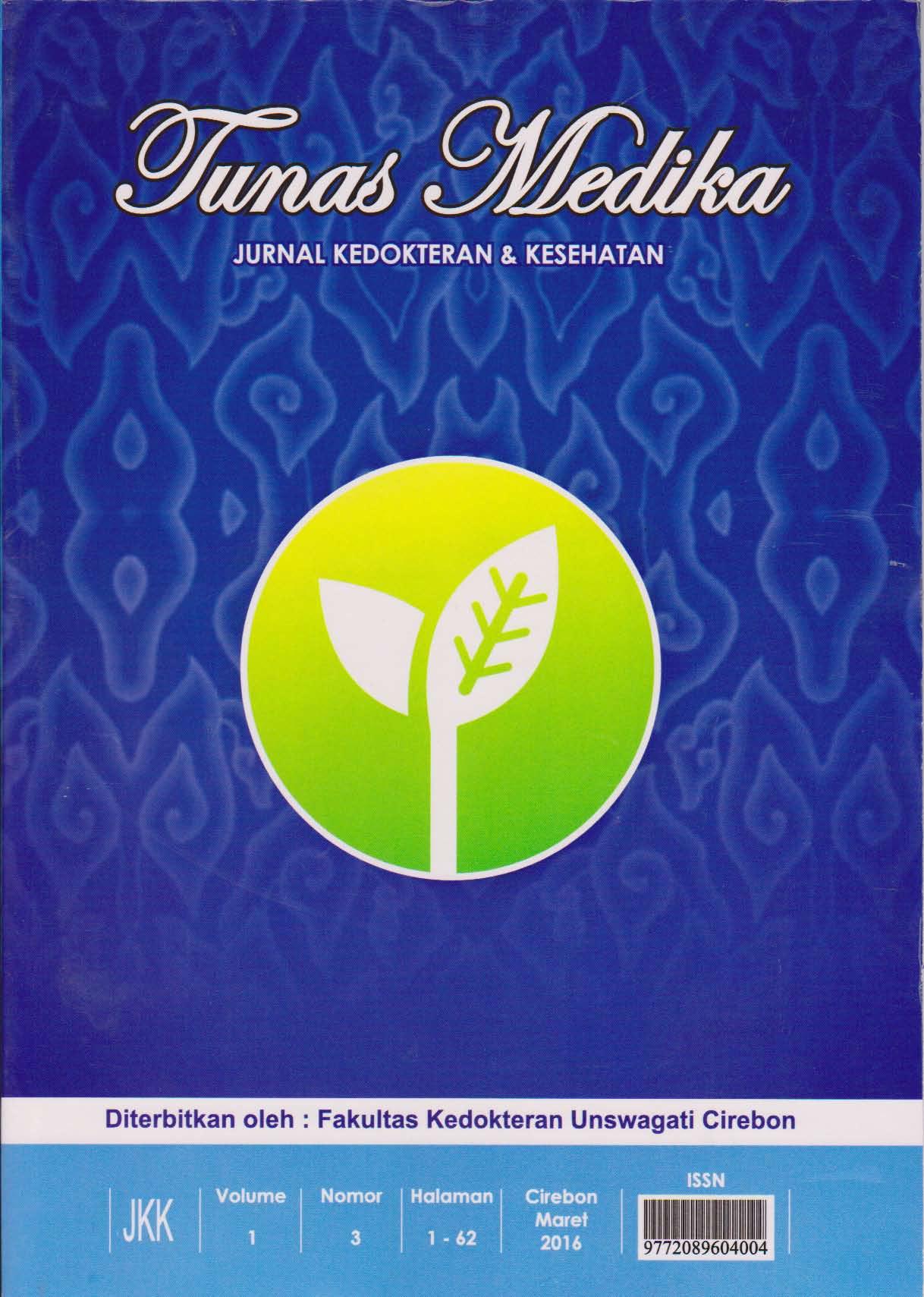Gambaran Klinis Pasien Laringomalasia di Poliklinik Telinga Hidung Tenggorok Bedah Kepala Leher Rumah Sakit Dr. Hasan Sadikin Bandung Periode Januari 2012 - Maret 2015
DOI:
https://doi.org/10.33603/tumed.v3i1.265Abstract
Latar Belakang: Laringomalasia merupakan salah satu kelainan kongenital yang terjadi akibat jatuhnya struktur supraglotik selama inspirasi sehingga menyebabkan stridor. Laringomalasia terdiri dari 3 tipe. Faktor risiko laringomalasia adalah lahir prematur, kelainan neurologik dan lesi jalan nafas. Faktor komorbid laringomalasia adalah bronkopneumonia, kelainan jantung bawaan dan kelainan neurologik. Laringomalasia diduga memiliki hubungan yang erat dengan refluks isi lambung. Tujuan: memberikan informasi mengenai gambaran klinis laringomalasia berdasarkan tipe laringomalasia, faktor risiko, faktor komorbid, dan gambaran refluks laringofaring sehingga diharapkan penatalaksanaan yang lebih terpadu. Metode: penelitian deskriptif retrospektif dengan pendekatan potong lintang, di Poliklinik THT-KL RSHS Bandung periode Januari 2012-Maret 2015, berdasarkan data rekam medis, dan pemeriksaan laringoskopi serat lentur. Hasil: Terdapat 84 pasien (55 laki-laki dan 29 perempuan). Tipe laringomalasia terdiri dari tipe 1 (63,1%), tipe 2 (23,8%) dan tipe 3 (13,1%). Faktor risiko terbanyak adalah cerebral palsy (13%). Faktor komorbid berupa bronkopneumonia (53,6,5%), dan kelainan jantung bawaan (4,8%). Terdapat 2 gambaran refluks laringofaring, yaitu mukus kental endolaring (48,8%), dan hipertrofi komisura posterior (10,7%). Kesimpulan: Laringomalasia banyak terjadi pada laki-laki dibandingkan perempuan, tipe laringomalasia terbanyak adalah tipe 1 epiglotis berbentuk omega. Faktor risiko kelainan neurologik (cerebral palsy), faktor komorbid bronkopnemonia dan gambaran refluks laringofaring berupa mukus kental endolaring yang banyak terjadi.
Kata Kunci : Laringomalasia, Laringoskopi Serat Lentur
Background : Laryngomalacia is a congenital anomalies caused by the collapse of the supraglottic structures during inspiration and causing of stridor. Laryngomalacia consists of 3 types. Laryngomalacia risk factor is premature birth, neurological disorders and lesions of the airway. Laryngomalacia comorbidities was bronchopneumonia, congenital heart disease and neurological disorders. Laryngomalacia expected to have close links with the laryngopharyngeal reflux (LPR). Aim: provide information on the clinical manifestation of Laryngomalacia based on type Laryngomalacia, risk factors, comorbidities, and laryngopharyngeal reflux so expect a more unified management. Methods : retrospective descriptive study with cross-sectional approach in the outpatient of Otolaryngology-Head and Neck Surgery, Hasan Sadikin Hospital, Padjadjaran University, period January 2012-March 2015 from the medical sheats records and record video flexible fiberoptic laryngoscopy (FFL). Results : Eighty four patients were included in the study (59 males and 29 females). Risk factor in this study is cerebral palsy (13%) and the comorbid factor is bronchopneumonia (53,6,5%), cerebral palsy and congenital heart diseases (4,8%). The two clinical findings from LPR is endolaring mucus (48,8%), posterior commissure hypertrophy (10,7%). Conclusions : Laryngomalacia more common in men than women, the most Laryngomalacia type is type 1 omega-shaped epiglottis. Risk factors is neurological disorders (cerebral palsy), comorbidities bronchopneumonia and laryngopharyngeal reflux picture in form of viscous mucus that frequently occurred.
Keyword : Laryngomalacia, Flexible Fiberoptic Laryngoscopy.
References
Abel RM, Bush AB. Respiratory disorders in newborn. Chernick V, Boat TF, Wilmott RW, Bush
A. Kernig’s disorders of the respiratory tract in children. Edisi ke-7. Philadelphia : Saunders
Elsevier. 2006:291–2.
Kelley PE. Laringomalacia. Friedman M. Sleep apnea and snoring surgical and non-surgical
therapy. China : Saunders Elsevier. 2009:437–43.
Desir SL, Bye MR. Laringomalacia. 2012. Tersedia dari : http://www.emedicine.com/ped
/topic1280.htm.
Gerber ME, Holinger LD. Congenital laryngeal anomalies. Blustone C, Stool, Alper, et all.
Pediatric Otolaryngology. Edisi 4. 2003:1460–63.
Ballenger JJ. Penyakit telinga, hidung, tenggorok, kepala dan leher, Jilid Satu, Edisi 13. Binarupa
Aksara. Jakarta. 1994.
Ayari S, Aubertin G, Girschig H, Abeele TVD, Mondain M. Pathophysiology and diagnostic
approach of laryngomalacia in infants. European Annals of Otorhinolaryngology, Head and
Neck diseases. 2012;129:257–63
Landry AM, Thompson DM. Laryngomalacia: Disease presentation, spectrum, and
management. International Journal of Pediatric. 2012.
Kay DJ, Goldsmith AJ. Laringomalacia: A classification system and surgical treatment strategy.
Ear Nose Throat. 2006;85(5):328–31.
Holinger LD. Laryngomalacia. Dalam: Kliegman RM, Behrman RE, Jenson HB, Stanton BF,
penyunting. Nelson textbook of pediatrics. Edisi ke-19. Philadephia: Saunders Elsevier.
:1480–81.
Garna H, Nataprawira HM. Laringomalasia. Pedoman Diagnosis dan Terapi Ilmu Kesehatan
Anak. Edisi ke-5. 2014:1018–20.
Mukerji Shraddha, Pine Harold. Current concepts in diagnosis and management of
laryngomalacia. Grand Rounds Presentation, UTMB, Dept. of Otolaryngology. 2009.
Ayari S, Aubertin G, Girschig H, Abeele TVD, et all. Management of laryngomalacia. European
annals of Otorhinolaryngology, Head And Neck Diseases. 2013;130:15–21.
Fattah HA, Gaafar AH, Mandour ZM. Laringomalacia: Diagnosis and management. Egyptian
Journal of Ear, Nose, Throat and Allied Sciences. 2011;12:149–153.
Olney DR, JH Greinwald, RJ Smith, NM Bauman. Laryngomalacia and its treatment. Pubmed.
;109(11):1770–5.
Nasution DP, Tamin S, Hutauruk S, Bardosono S. Prevalensi refluks laringofaring pada bayi
laringomalasia primer. Oto Rhino Laringologica Indonesia. 2012;42:1–2







